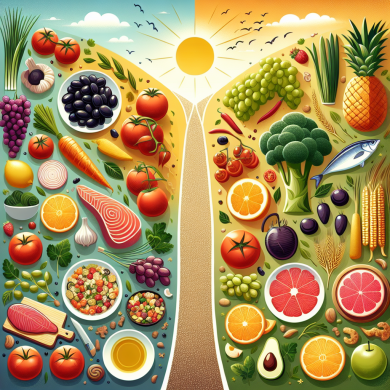Lower Blood Pressure Naturally with DASH Diet
Introduction
High blood pressure, or hypertension, is a common health issue that affects millions of people worldwide. This condition can increase the risk of heart disease, stroke, and other serious health problems. Fortunately, there are natural ways to manage and even lower blood pressure, one of which is through the Dietary Approaches to Stop Hypertension, known as the DASH diet. This article explores how the DASH diet can help lower blood pressure naturally and improve overall health.
Understanding Hypertension
Hypertension is often termed the “silent killer” because it typically lacks obvious symptoms but can lead to severe health complications over time. Blood pressure is the force exerted by circulating blood against the walls of the body’s arteries, the major blood vessels in the body. Hypertension occurs when this force is consistently too high, causing the heart to work harder than normal to circulate blood.
The Risks of High Blood Pressure
Prolonged hypertension can damage the heart, kidneys, blood vessels, and other parts of the body. It can lead to heart disease, heart attack, stroke, and kidney failure. Therefore, managing blood pressure is crucial for maintaining long-term health.
What is the DASH Diet?
The DASH diet was developed to help individuals lower their blood pressure without medication. It emphasizes the consumption of foods that are rich in nutrients such as potassium, calcium, and magnesium, which are known to help control blood pressure. The diet is low in sodium, saturated fat, and added sugars, focusing instead on whole grains, fruits, vegetables, lean proteins, and low-fat dairy.
Components of the DASH Diet
To effectively lower blood pressure, the DASH diet includes specific recommendations for daily servings of different food groups. Below is a breakdown of these components:
Fruits and Vegetables
The DASH diet recommends consuming 4-5 servings of fruits and 4-5 servings of vegetables each day. These foods are rich in nutrients that are essential for heart health, such as fiber, potassium, and magnesium. Incorporating a variety of colorful fruits and vegetables ensures a broad spectrum of nutrients.
Whole Grains
Whole grains are a staple of the DASH diet, with a recommendation of 6-8 servings per day. Whole grains such as brown rice, quinoa, oats, and whole wheat bread are high in fiber and help regulate blood sugar levels, reducing the risk of heart disease.
Lean Proteins
Protein is an important part of a balanced diet, and the DASH diet suggests 2 or fewer servings of lean meats, poultry, or fish per day. It also encourages plant-based proteins like beans, lentils, and nuts, which provide additional nutrients and healthy fats.
Low-Fat Dairy
Low-fat or fat-free dairy products provide calcium and vitamin D, which are crucial for bone health. The DASH diet recommends 2-3 servings of dairy per day, including milk, yogurt, and cheese.
Nuts, Seeds, and Legumes
Nuts, seeds, and legumes are excellent sources of protein, fiber, and healthy fats. The DASH diet includes 4-5 servings per week, which can enhance heart health and reduce blood pressure.
Fats and Oils
Healthy fats are included in the DASH diet in moderation, with a recommendation of 2-3 servings per day. Unsaturated fats such as those found in olive oil, avocados, and fatty fish are preferred over saturated fats.
Sweets and Sodium
The DASH diet limits sweets and added sugars to no more than 5 servings per week and recommends reducing sodium intake to 2,300 milligrams per day, or even 1,500 milligrams for greater blood pressure reduction.
Benefits of the DASH Diet
Following the DASH diet offers numerous benefits beyond lowering blood pressure. These include weight loss, improved cholesterol levels, reduced risk of heart disease, and better management of diabetes.
Weight Loss and Management
The DASH diet’s emphasis on whole foods and portion control can lead to weight loss, which is beneficial for reducing blood pressure. Maintaining a healthy weight is crucial for cardiovascular health.
Improved Cholesterol Levels
By reducing saturated fats and cholesterol intake, the DASH diet can help lower LDL (bad) cholesterol levels, further protecting the heart.
Reduced Risk of Heart Disease
The combination of lower blood pressure, improved cholesterol levels, and better weight management significantly reduces the risk of heart disease.
Better Management of Diabetes
The DASH diet is rich in fiber and whole grains, which help stabilize blood sugar levels and can be beneficial for individuals with diabetes or those at risk of developing the condition.
Tips for Implementing the DASH Diet
Switching to the DASH diet can be a gradual process. Here are some tips to help you get started:
Plan Your Meals
Take time to plan your meals for the week, focusing on incorporating the recommended servings from each food group. This can help ensure that you are meeting the diet’s nutritional guidelines.
Gradual Changes
Make small changes to your diet over time. Start by adding more fruits and vegetables to your meals and gradually reduce your sodium intake by using herbs and spices for flavor instead of salt.
Read Labels
Pay attention to food labels to make informed choices about the foods you consume. Look for options that are low in sodium and added sugars.
Stay Hydrated
Drink plenty of water throughout the day to stay hydrated and help your body function optimally.
Conclusion
The DASH diet is a powerful tool for lowering blood pressure naturally and improving overall health. By focusing on nutrient-rich foods and reducing sodium and unhealthy fats, individuals can achieve significant health benefits, including reduced blood pressure, improved heart health, and better weight management. Implementing the DASH diet doesn’t require drastic changes but rather a commitment to making healthier choices that can have lasting positive effects on your well-being.















Add comment